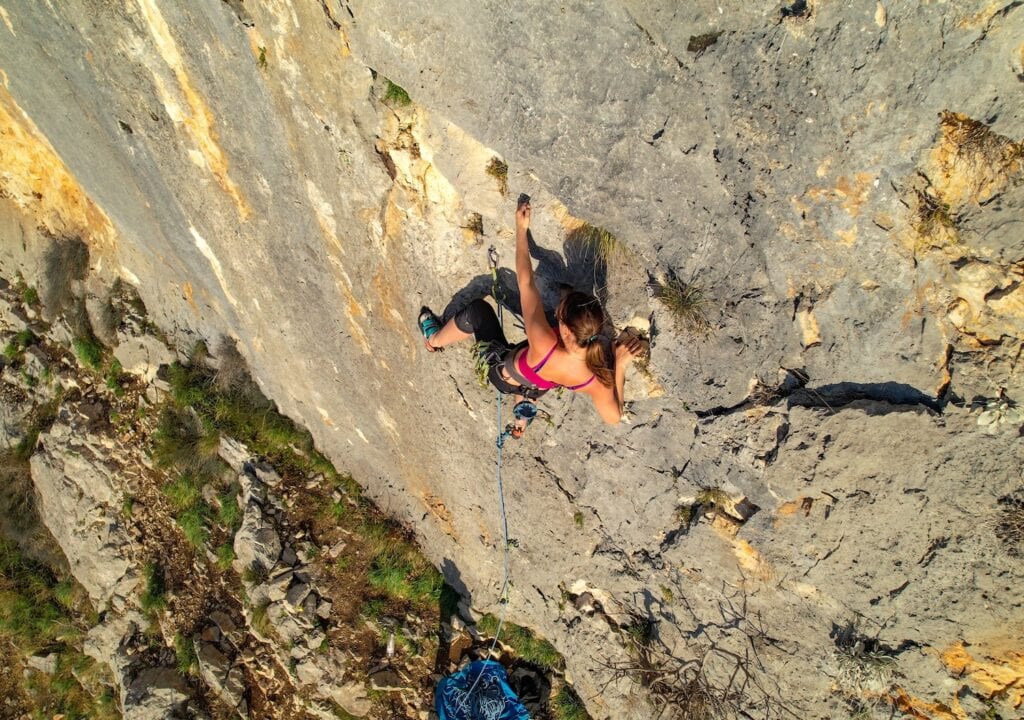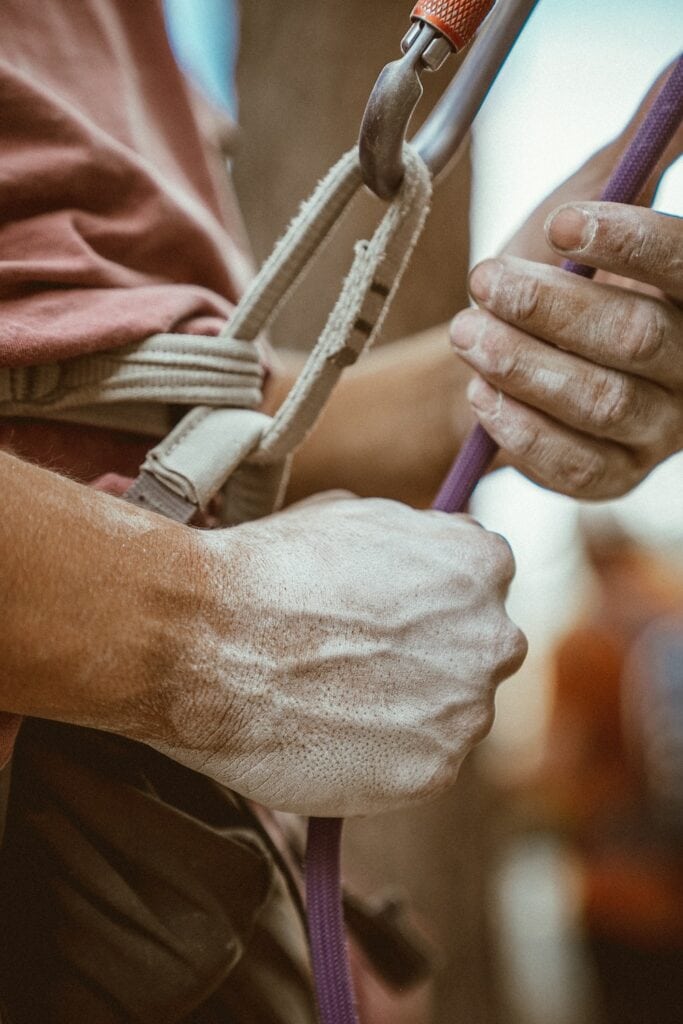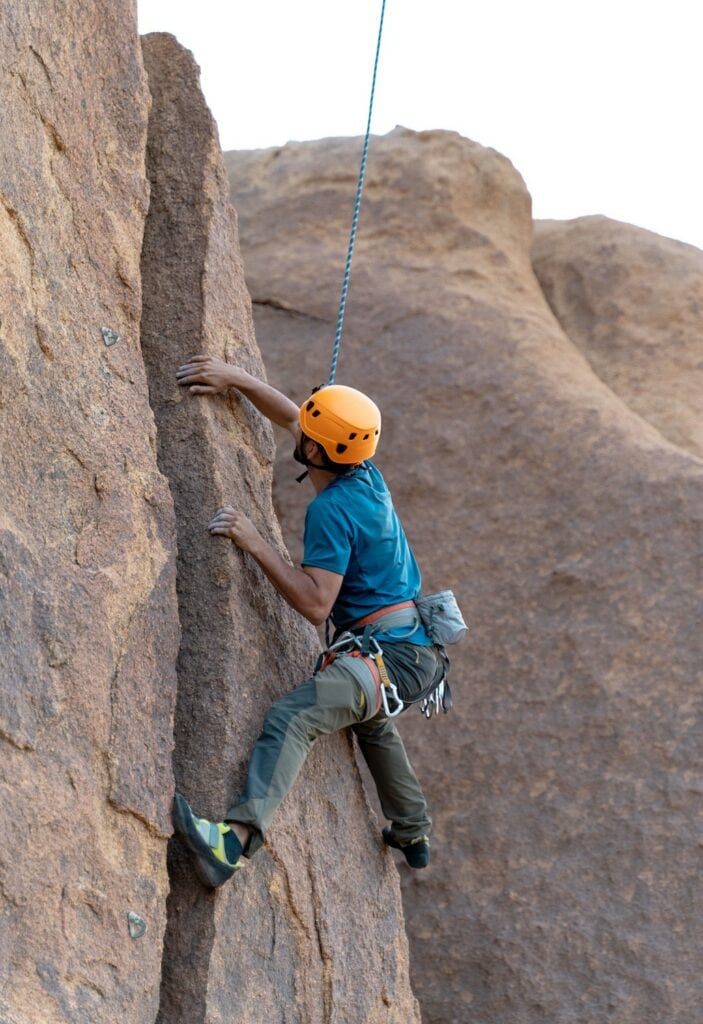How to Conquer Your Climbing Fear of Falling (2024 Guide)

Published on: 06/22/2023
Fear of falling is one of the most significant obstacles that climbers face. It’s a natural, genetically determined reaction designed to protect us from danger. But what if you could conquer this fear and unlock your full climbing potential? In this comprehensive guide, we’ll explore strategies to be less afraid and reach new heights!
Short Summary
• Conquer your fear of falling by developing trust trust in gear and belayer, mastering falls techniques & mental training.
• Develop focus and composure by practicing mindfulness & positive self-talk.
• Visualize success to boost confidence and crush your projects.
Understanding Your Fear of Falling
There are two important concepts to understand the fear of falling in the context of rock climbing:
- Fear of falling (basophobia)
- Fear of heights (acrophobia)
Studies suggest that these fears are mainly an innate, genetically determined reaction that aims at protecting the body (1, 2). However, some researchers also argue that they arise from non-traumatic falling experiences (3).
In other words, it’s natural to feel scared when climbing, especially when trying challenging routes or pushing our limits. That’s how we are wired. Of course, it’s important to distinguish between reasonable fear and irrational phobia resulting in panic episodes.
While the latter may require the help of a medical professional, you can work on the former as part of your climbing practice. Indeed, studies suggest that the inherited fear of heights and falling can be vanquished by regular exposure (4).
Note: you may also have read or heard the term “climacophobia” or fear of climbing any slope like stairs. However, this type of phobia is rare and mostly happens after a traumatic event (5).

The role of fear in climbing
Being afraid of falling affects most climbers to varying degrees. It can hinder our progress, making us hesitant to take risks, and ultimately limit our climbing abilities. The first step in conquering this fear is to acknowledge its presence and understand its purpose: to protect us from potential harm.
To effectively overcome your fear, it’s essential to practice falling in a safe and controlled environment, such as a climbing gym. With the support of an experienced belayer or spotter you can gradually build your confidence by taking small falls and learning how to react instinctively and protect yourself in any scenario, even new ones.
By facing your fear head-on and mastering the art of falling, you’ll be better equipped to handle challenging climbs and push your limits, ultimately overcoming fear.
Identifying and overcoming natural fear is one of the pleasing struggles intrinsic to climbing.
Alex Lowe
Identifying personal triggers
Common triggers of fear of falling in climbing include high routes, making difficult moves, doubting the gear, and traumatic experiences like an awkward fall that left you scare or even worse, injured. Recognizing these triggers is crucial in understanding and managing your irrational fear.
By reflecting on your past climbing experiences and observing your reactions during climbs, you can identify your personal triggers and work on strategies to overcome them. With practice and persistence, you’ll eventually learn to control your fear response, allowing you to climb with greater confidence and enjoyment.
Conquering climbing fear doesn’t mean becoming reckless
To quote Alex Lowe again, “When you remove the risk, you remove the challenge.” However, Lowe himself was very safety-conscious and only took calculated risks. Conquering your fear of falling means becoming comfortable with it, but it’s certainly not the same as getting rid of it and plowing through climbs head on regardless of the risks.
As you gain experience and skills as a climber, you’ll also recognize that some potential falls are very dangerous and should be avoided at all costs. For example, a boulder can be too high to protect, or a sport route may not have enough bolts. In such scenarios, use your judgment to evaluate the risks. Similarly, while climbing, there may be better alternatives to falling if you feel that you are in a dangerous situation (e.g. grabbing a quickdraw or downclimbing to a safer position).
Building Trust in Your Gear and Belayer

Trusting your safety gear and belayer is essential for roped climbing. When we feel confident in our gear and the person holding the other end of the rope, our fears diminish, allowing us to concentrate on our movement and tasks instead of doubting and starting a “what ifs” loop in our heads.
Choosing the right gear
Who’s never wondered whether it’s possible for the rope to snap while we are lowering, or how strong that belay loop really is. While such accidents happen, they are extremely rare. And when they do occur, most of the time it’s because the gear was too old or had been altered in some way (e.g. chemicals can weaken a rope and lead to failure).
Therefore, it’s crucial to store your gear properly and regularly inspect it to make sure it’s still safe to use for climbing. Your ropes, slings, and harness are the obvious priorities, but you shouldn’t neglect other pieces of equipment like carabiners. If you have any doubts, check with a professional or replace the gear.
Investing in quality equipment and taking proper care of it will make you feel more confident and secure in your climbing abilities, ultimately helping you overcome your fear of falling.
Developing trust with your belayer or spotter

Your safety while climbing relies heavily on your belayer, the person who manages the rope’s slack as you ascend. The belayer’s responsibilities include:
- Stopping your fall with the combination of their weight and belay device secured to their harness
- Giving and taking slack appropriately as you ascend
- Lowering you to the ground once you reached the top of the route (in single-pitch climbing)
Having a trustworthy and experienced belayer is vital in overcoming your fear, especially during your first few falls. Even better, a reliable belayer can provide you with the support and encouragement you need to push beyond your comfort zone and reach new heights in your climbing journey.
The belayer’s role is even more important in lead climbing as they also need to dynamize the fall to make it soft and protect the climber’s back while minding the fall distance to prevent a ground fall or ledge/wall crash.
To find experienced climbers, try connecting with knowledgeable climbers at your local gym or crag, or ask gym staff for recommendations. As you build a strong relationship with your belayer, you’ll gain the confidence to take on more challenging climbs, knowing that they’ve got your back.
If you pair with someone new and are unsure about their abilities, it’s good practice to rehearse on the ground to ensure they master all the required techniques. You can also insist they use an assisted-breaking belaying device like the GriGri.
Mastering Falling Techniques
Mastering falling techniques is a key component in conquering your fear of falling in climbing. By learning how to fall correctly and safely, you’ll reduce anxiety and increase your confidence on the wall.
Top-rope falls
Top-roping falls are a great starting point for practicing falling, as the rope above you provides a sense of security, and the fall distance is typically short. It’s the perfect way to get familiar with the feeling of dropping into the void.
However, top rope shouldn’t be dismissed as trivial either. It’s an important step for beginners, and it’s important to take it slowly. Also, if climbing an overhung or curving route, the climber’s rope should go through quickdraws to avoid swinging, especially outdoors.
When taking controlled falls while climbing second, focus on maintaining a relaxed body position and proper breathing. As you become more comfortable with top-rope falls, you’ll be better prepared to face the more challenging falls experienced in lead climbing.
Lead climbing falls
Lead climbing falls are scary because the climber is often positioned above the last bolt securing the rope. As a result, the climber feels like they are free-falling into the abyss until the anchors catch their weight.
Leading a route can result in a big fall because of the runout (distance between the climber and the last anchor), the stretch of the dynamic rope, and potential slack (especially if the climber falls when they’re attempting to clip the rope).
Overall, climbers feel afraid of lead climbing falls because of the many things that can go wrong. For example, the climber can flip upside down if the rope is behind their leg when they fall; the belayer can give a “hard catch,” which can be painful; or the climber can hit the ground or a ledge if they fall early in the route or if there’s too much slack.
Lead falling practice
Unfortunately, there are many falling parameters to consider on a lead climb, and most rely on the belayer. As a climber, the most important thing you can do is practice, practice, and practice.
Take lead falls in a safe environment like a climbing gym or an outdoor area with clear and slightly overhanging routes. Ensure you are high enough above the ground and start falling when you are at the level of the last quickdraw you’re clipped to. Once familiar with this, progressively start experimenting with falling above the quickdraw until you’re almost at the next one. This process can happen across a few sessions; you don’t have to try everything right away!
As climbing coach Dave MacLeod recommends (6), falling should become an integral part of your practice. It’s not something to do occasionally, or the fear will slowly start creeping again. For example, instead of asking your belaying partner to block you when you’re not sure about the next move at the gym, instead go for the fall!

Bouldering falls
While seemingly safer due to the closeness to the ground (most boulder problems are 15-feet/5-meter high at most), bouldering can be quite dangerous because climbers typically don’t wear helmets, and hitting the ground (even protected by a crash pad) can be tricky at first.
To conquer your fear of falling while bouldering, you must learn proper technique from a qualified instructor. Like in martial arts like judo or aikido, bouldering requires breaking your fall to protect your body from dangerous shocks. This involves landing with your knees bent and falling backwards or in spiral to absorbe the impact’s force. Once you have mastered the technique, you’ll need to practice over and over again like with lead climbing.
Outdoor bouldering presents further challenges as the crash pads are not permanently installed. You’ll need to work with your spotters to ensure the entire fall area is protected.
Integrating Mental Training with Physical Practice
Integrating mental training with physical training is crucial in conquering your fear of falling in climbing. Mental strategies such as mindfulness, positive self-talk, and visualization can significantly enhance your fall practice, helping you overcome fear and achieve your climbing goals. By taking practice falls, you can further improve your physical and mental preparedness for climbing challenges.
In this section, we’ll delve into these mental practices and discuss how they can be incorporated into your climbing routine to improve your overall performance and tackle your fears head-on.
Mindfulness
Mindfulness is a powerful tool that can help you stay present and focused during your climbs, allowing you to manage anxiety and fear better. It consists of focusing on the present moment with complete awareness, acknowledging your thoughts but not letting them distract your focus. By practicing mindfulness, you can bring your attention to the task at hand and avoid getting lost in racing thoughts or worries about falling.
To incorporate mindfulness into your climbing routine, try focusing on the rock, the holds in front of you, or simply taking a deep breath. You can also take yoga lessons with a focus on breathing exercises (pranayama) and meditation. As you cultivate a mindful approach to climbing, you’ll find it easier to stay calm and composed, even in challenging situations.
Positive self-talk
Positive self-talk can be a game-changer for climbers, helping boost confidence, sharpen focus, and enhance overall performance. By reframing negative thoughts and focusing on positive affirmations, you can empower yourself to view your fear in a more constructive way, enabling you to concentrate on the task at hand and take action.
Incorporate positive self-talk into your climbing routine by offering yourself words of encouragement and support, reminding yourself of your strengths, and visualizing successful outcomes. As you practice positive self-talk, you’ll notice a significant improvement in your confidence and ability to face fear head-on.
Visualization techniques
Visualization techniques can be a powerful mental tool for climbers, helping you mentally prepare for a climb, refine movement sequences, and even overcome fear of falling. By creating a mental image of your desired outcome or goal, you can prime your mind for success and boost your confidence on the wall.
To practice visualization techniques, try imagining yourself successfully completing a challenging route or visualizing a safe and controlled fall. By regularly incorporating visualization into your climbing routine, you’ll be better equipped to tackle fear and achieve your climbing goals.
Summary
Conquering your fear of falling in climbing is a journey that requires mental and physical training. By understanding your fear, building trust in your gear and belayer, mastering falling techniques, and incorporating mindfulness, positive self-talk, and visualization techniques, you can overcome your fear and unlock your full climbing potential.
Remember, climbing is a sport that challenges both the body and the mind. As you continue to push your limits and face your fears, one of the many benefits of climbing is that you’ll develop mental resilience and courage that will serve you in everyday life.
References
The etiology of acrophobia and its relationship to severity and individual response patterns
Menzies and Clarke Sep 1995
Behaviour Research and Therapy
https://www.sciencedirect.com/science/article/abs/pii/000579679500023Q
The use of virtual reality in acrophobia research and treatment
Coelho et al., June 2009
Journal of Anxiety Disorders
https://www.sciencedirect.com/science/article/abs/pii/S0887618509000280
Evidence for a non-associative model of the acquisition of a fear of heights
Poulton et al., May 1998
Behaviour Research and Therapy
https://www.sciencedirect.com/science/article/abs/pii/S0005796797100377
Failure to overcome ‘innate’ fear: a developmental test of the non-associative model of fear acquisition
Poulton et al., Jan 2001
Behaviour Research and Therapy
https://www.sciencedirect.com/science/article/abs/pii/S0005796799001564
Climacophobia
Lisa Fritscher and Daniel B. Block, MD, Oct 2020
Verywell Mind
https://www.verywellmind.com/climacophobia-2671852
9 Out of 10 Climbers Make the Same Mistakes
Dave MacLeod, Nov 2009
Rare Breed Productions
ISBN 10: 095642810X
